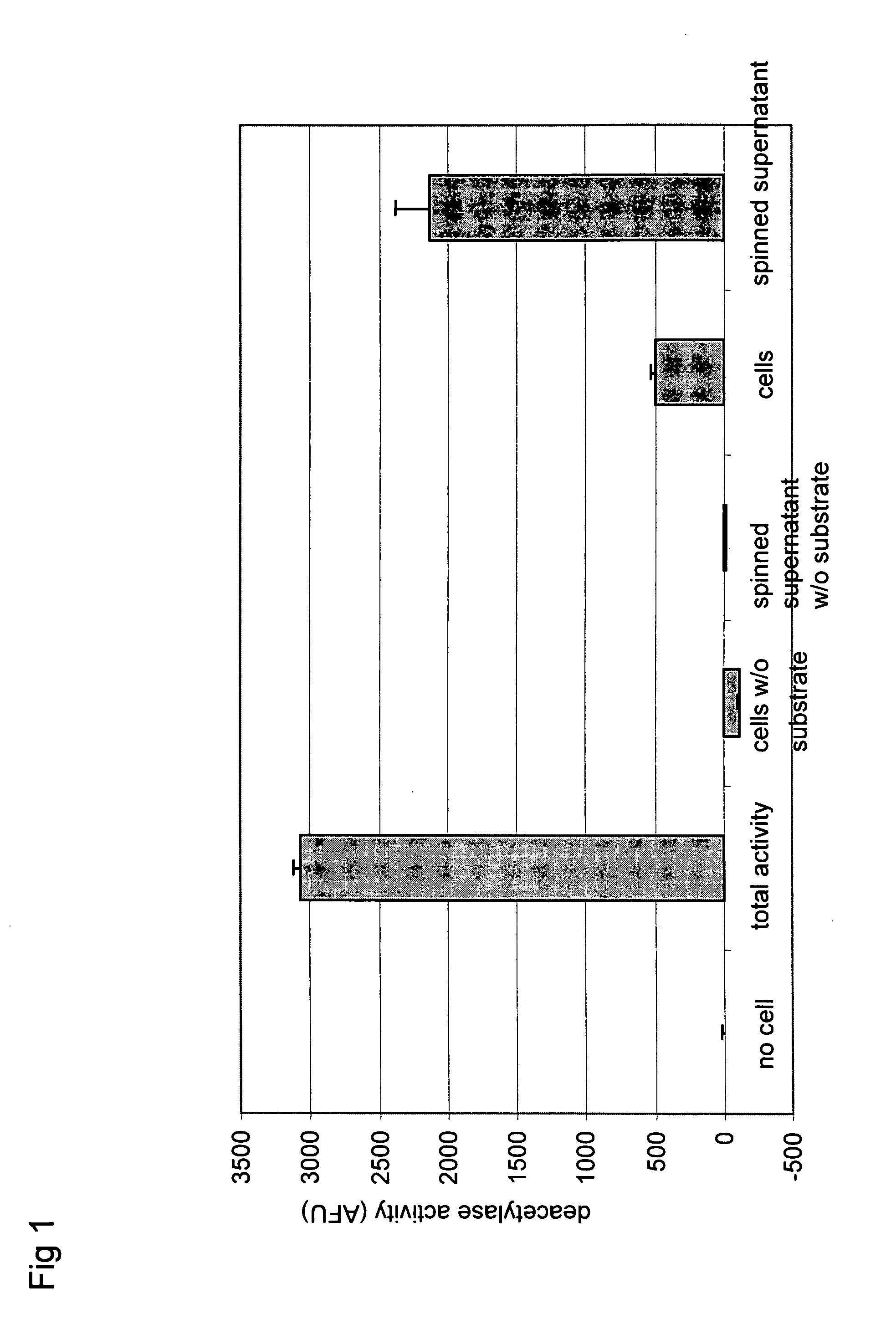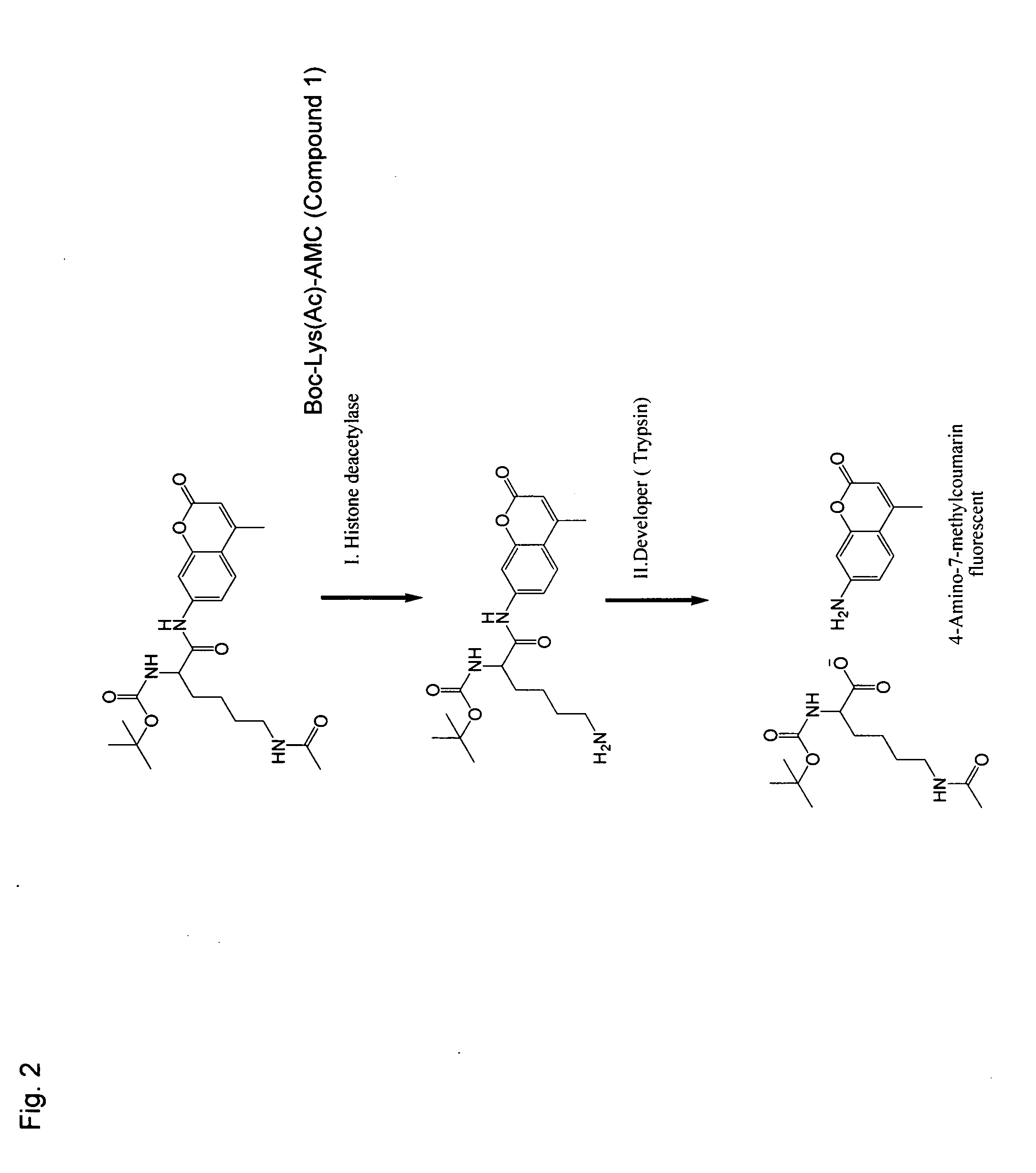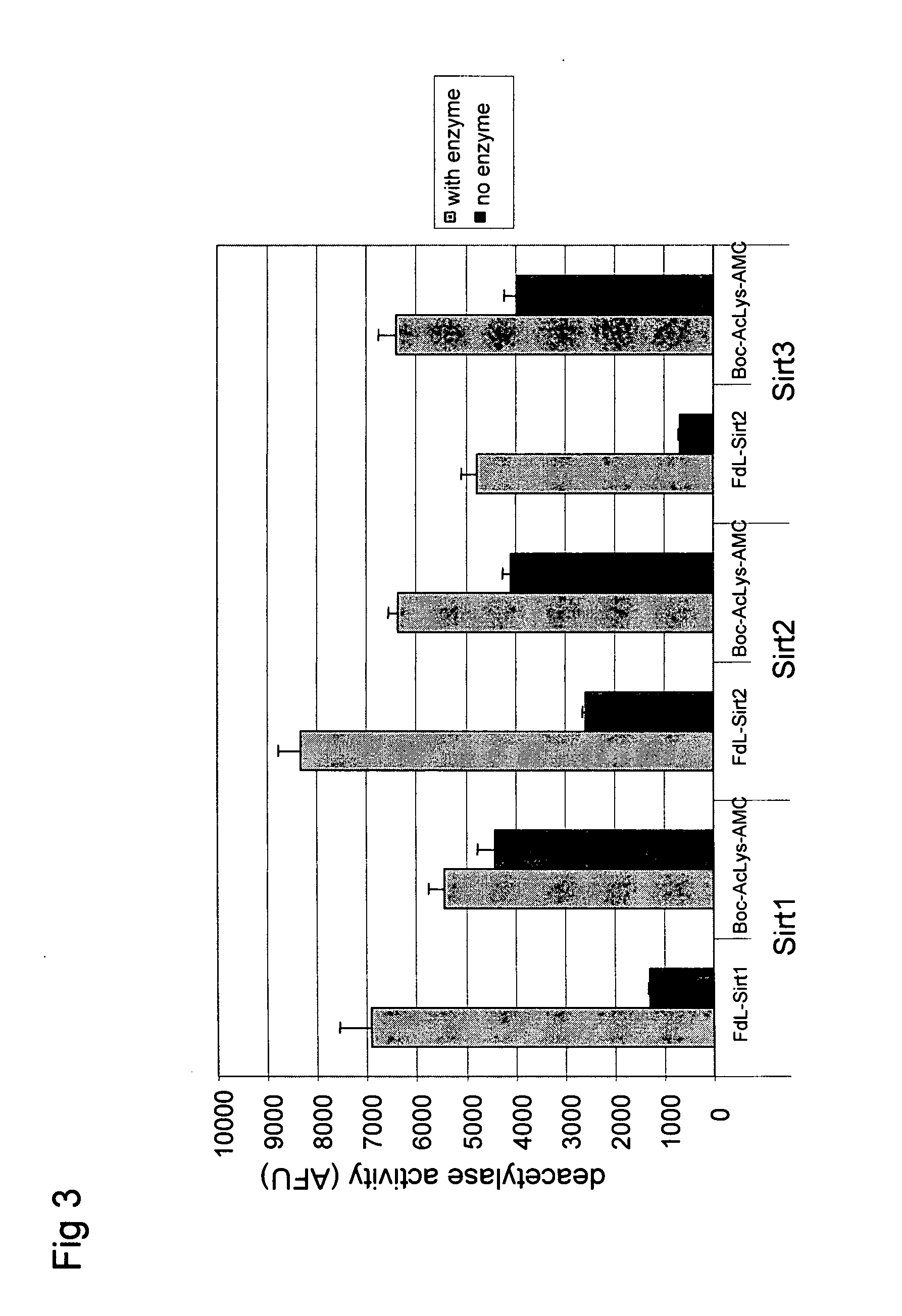[0028] In a ninth aspect, the invention provides a method for assessing the efficacy of an isotype-specific inhibitor of one or more member of a protein deacetylase family in mammals in vivo by measuring the quantity of a detectable reporter molecule in bodily fluids. In the method according to this aspect of the invention, the mammal is administered a cell-permeable isotype-specific substrate for the one or more member of a protein deacetylase family, wherein deacetylation of the isotype-specific substrate generates the detectable reporter molecule. Bodily fluids from the mammal are obtained and the quantity of the detectable reporter molecule in the bodily fluids is determined. The mammal is then administered an isotype-specific inhibitor of one or more member of a protein deacetylase family and after an appropriate time period the mammal is administered the isotype-specific substrate. Bodily fluids from the mammal are obtained and the quantity of the detectable reporter molecule in the bodily fluids is determined. The quantity of detectable reporter molecule in bodily fluids obtained prior to administration of the isotype-specific inhibitor is then compared with the quantity of the detectable reporter molecule in bodily fluids after administration of the isotype-specific inhibitor. Significant decrease in the quantity of the reporter molecule after administration of the isotype-specific inhibitor is taken as a measure of efficacy. In certain preferred embodiments, the protein deacetylase family is the histone deacetylase (HDAC) family. In certain preferred embodiments, the protein deacetylase family is the Sir2 family.
[0029] In a tenth aspect, the invention provides a method for assessing the efficacy of a pan-activator of a protein deacetylase family or one or more member thereof in vivo. In the method according to this aspect of the invention, whole cells are provided from a mammal. The cells are contacted with a pan-substrate for the protein deacetylase family or an isotype specific substrate, wherein deacetylation of the substrate by the protein deacetylase family or one or more members thereof generates a detectable reporter molecule. The quantity of the reporter molecule is then determined. In preferred embodiments, the quantity is standardized against a known activity of the protein deacetylase family or the one or more members thereof. Next, the mammal is administered the pan-activator. After an appropriate period of time, whole cells are again taken from the mammal and contacted with the pan-substrate. Next the quantity of the reporter molecule determined. In preferred embodiments, the quantity is standardized against a known activity of the protein deacetylase family or the one or more members thereof. Then the quantity of the reporter molecule after administration of the pan-activator is compared with the quantity of the reporter molecule before administration before administration of the pan-activator. Significant increase in the quantity of the reporter molecule after administration of the pan-activator is taken as a measure of efficacy. In certain preferred embodiments, the protein deacetylase family is the histone deacetylase (HDAC) family. In certain preferred embodiments, the protein deacetylase family is the Sir2 family.
[0030] In an eleventh aspect, the invention provides a method for assessing the efficacy and specificity of an isotype-specific activator for of one or more member of a protein deacetylase family in vivo. In the method according to this aspect of the invention, whole cells are provided from a mammal. The cells are contacted with an isotype-specific substrate for the one or more member of the protein deacetylase family, wherein deacetylation of the substrate by the protein deacetylase generates a detectable reporter molecule. The quantity of the reporter molecule is then determined. In preferred embodiments, the quantity is standardized against a known activity of the member of the protein deacetylase family. Next, the mammal is administered the isotype-specific activator. After an appropriate period of time, whole cells are again taken from the mammal and contacted with the isotype-specific substrate. Next the quantity of the reporter molecule determined. In preferred embodiments, the quantity is standardized against a known activity of the one or more member of the protein deacetylase family. Then the quantity of the reporter molecule after administration of the isotype-specific activator is compared with the quantity of the reporter molecule before administration of the isotype-specific activator. Significant increase in the quantity of the reporter molecule after administration of the isotype-specific activator is taken as a measure of efficacy. In certain preferred embodiments, the protein deacetylase family is the histone deacetylase (HDAC) family. In certain preferred embodiments, the protein deacetylase family is the Sir2 family.
[0031] In a twelfth aspect, the invention provides a method for assessing the efficacy of a pan-activator of total protein deacetylase family of mammals or one or more members thereof in vivo by measuring the quantity of a detectable reporter molecule in bodily fluids. In the method according to this aspect of the invention, the mammal is administered a cell-permeable pan-substrate for a protein deacetylase family or one or more members thereof or an isotype specific substrate, wherein deacetylation of the pan-substrate or isotype-specific substrate generates the detectable reporter molecule. Bodily fluids from the mammal are obtained and the quantity of the detectable reporter molecule in the bodily fluids is determined. The mammal is then administered the pan-activator of the protein deacetylase family and after an appropriate time period the mammal is administered the pan-substrate or isotype specific substrate. Bodily fluids from the mammal are obtained and the quantity of the detectable reporter molecule in the bodily fluids is determined. The quantity of detectable reporter molecule in bodily fluids obtained prior to administration of the pan-activator is then compared with the quantity of the detectable reporter molecule in bodily fluids after administration of the pan-activator. Significant increase in the quantity of the reporter molecule after administration of the pan-activator is taken as a measure of efficacy. In certain preferred embodiments, the protein deacetylase is a member of the histone deacetylase (HDAC) family. In certain preferred embodiments, the protein deacetylase is a member of the Sir2 family.
[0032] In a thirteenth aspect, the invention provides a method for assessing the efficacy of an isotype-specific activator of one or more member of a protein deacetylase family in mammals in vivo by measuring the quantity of a detectable reporter molecule in bodily fluids. In the method according to this aspect of the invention, the mammal is administered a cell-permeable isotype-specific substrate for protein deacetylases, wherein deacetylation of the isotype-specific substrate generates the detectable reporter molecule. Bodily fluids from the mammal are obtained and the quantity of the detectable reporter molecule in the bodily fluids is determined. The mammal is then administered an isotype-specific activator of one or more member of a protein deacetylase family and after an appropriate time period the mammal is administered the isotype-specific substrate. Bodily fluids from the mammal are obtained and the quantity of the detectable reporter molecule in the bodily fluids is determined. The quantity of detectable reporter molecule in bodily fluids obtained prior to administration of the isotype-specific activator is then compared with the quantity of the detectable reporter molecule in bodily fluids after administration of the isotype-specific activator. Significant increase in the quantity of the reporter molecule after administration of the isotype-specific activator is taken as a measure of efficacy. In certain preferred embodiments, the protein deacetylase family is the histone deacetylase (HDAC) family. In certain preferred embodiments, the protein deacetylase family is the Sir2 family.
[0033] In a fourteenth aspect, the invention provides a method for assessing the activity of a candidate pan-activator of a protein deacetylase family or one or more members thereof in whole cells ex vivo. In the method according to this aspect of the invention whole cells from a mammal are provided and contacted with a cell-permeable pan-substrate for the protein deacetylase family or an isotype-specific substrate, wherein deacetylation of the substrate by the protein deacetylase family or one or more members thereof generates a detectable reporter molecule. A first aliquot of the cells is further contacted with a candidate pan-activator of the protein deacetylase family a second aliquot of the cells is not. The quantity of the detectable reporter molecule is then measured for the first and second aliquots and the quantity of protein deacetylase activity for each aliquot is compared. In preferred embodiments, the quantity of the detectable reporter molecule is measured against a control standard for the protein deacetylase family or the one or more members thereof.
 Login to View More
Login to View More 


